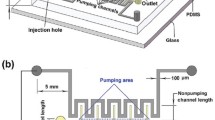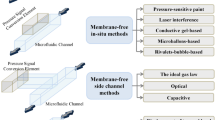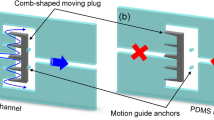Abstract
Microfluidic devices are operated at a low-Reynolds-number flow regime such that the transportation and mixing of fluids are naturally challenging. There is still a great need to integrate fluid control systems such as pumps, valves and mixers with other functional microfluidic devices to form a micro-total-analysis-system. This study presents a new pneumatic microfluidic rotary device capable of transporting and mixing two different kinds of samples in an annular microchannel by using MEMS (Micro-electro-mechanical-systems) technology. Pumping and mixing can be achieved using a single device with different operation modes. The micropump has four membranes with an annular layout and is compact in size. The new device has a maximum pumping rate of 165.7 μL/min at a driving frequency of 17 Hz and an air pressure of 30 psi. Experimental data show that the pumping rate increases as higher air pressure and driving frequency are applied. In addition, not only can the microfluidic rotary device work as a peristaltic pumping device, but it also is an effective mixing device. The performance of the micromixer is extensively characterized. Experimental data indicate that a mixing index as high as 96.3% can be achieved. The developed microfluidic rotary device can be easily integrated with other microfluidic devices due to its simple and reliable PDMS fabrication process. The development of the microfluidic rotary device can be promising for micro-total-analysis-systems.











Similar content being viewed by others
Abbreviations
- C :
-
Concentration
- CCD:
-
Charge coupled device
- C o :
-
Initial fluorescent concentration
- C + :
-
Normalized concentration (=C/C o)
- C ∞ :
-
Normalized complete mixed concentration (=0.5)
- DI:
-
Deionized
- ELISA:
-
Enzyme-linked immunosorbent assay
- EMV:
-
Electromagnetic valve
- f EMV :
-
Driving frequency of the electromagnetic valve (Hz)
- f mixing :
-
Driving frequency of the rotary micromixer (Hz)
- FITC:
-
Fluorescein isothiocyanate
- H :
-
Channel width
- LCD:
-
Liquid crystal display
- MEMS:
-
Micro-electro-mechanical-systems
- PDMS:
-
Polydimethylsiloxane
- PR:
-
Photoresist
- X :
-
Longitudinal coordinate
- Y + :
-
Normalized transversal coordinate (=y/h)
- Y :
-
Transversal coordinate
- σ :
-
Mixing index
References
C.C. Chang, R.J. Yang, J. Micromechanics Microengineering 14, 550 (2004)
H.P. Chou, M.A. Unger, A. Scherer, S.R. Quake, in Proceedings of the Solid State Actuator and Sensor Workshop, 2000
H.P. Chou, M.A. Unger, S.R. Quake, Biomed. Microdevices 3, 323 (2001)
D.C. Duffy, H.L. Gillis, J. Lin, N.F. Sheppard, G.J. Kellogg, Anal. Chem. 15, 4669 (1999)
A.Y. Fu, H.P. Chou, C. Spence, F.H. Arnold, S.R. Quake, Anal. Chem. 74, 2451 (2002)
I. Glasgow, N. Aubry, Lab Chip 3, 114 (2003)
P. Gravesen, Y. Branebjerg, O.S. Jensen, J. Micromechanics Microengineering 3, 168 (1993)
B.L. Gray, D. Jaeggi, N.J. Mourlas, B.P. Van Drieenhuizen, K.R. Williams, N. Maluf, G.T.A. Kovacs, Sens. Actuators, A 77, 57 (1998)
S. Hardt, F. Schonfeld, AIChE J. 49, 578 (2003)
V. Hessel, S. Hardt, H. Lowe, F. Schonfeld, AIChE J. 49, 566 (2003)
P. Hinsmann, J. Frank, P. Svasek, M. Harasek, B. Lendl, Lab Chip 1, 16 (2001)
C.C. Huang, S.B. Huang, G.B. Lee, J. Micromechanics Microengineering 16, 2265 (2006)
B. Husband, M. Bu, A.G.R. Evans, T. Melvin, J. Micromechanics Microengineering 14, 64 (2004)
H. Katoua, R. Miyakea, K. Kambarab, K. Kawaseb, H. Uchidab, Chem. Eng. Sci. 60, 5519 (2005)
M. Kochy, D. Chatelainz, A.G.R. Evan, A. Brunnschweiler, J. Micromechanics Microengineering 8, 123 (1998)
C.Y. Lee, G.B. Lee, L.M. Fu, H.K. Lee, R.J. Yang, J. Micromechanics Microengineering 14, 1390 (2004)
C.A. Li, T.N. Chen, Sens. Actuators, B 106, 871 (2005)
Y. Lin, G.J. Gerfen, D.L. Rousseau, S.R. Yeh, Am. Chem. Soc. 75, 5381 (2003)
J. Liu, M. Enzelberger, S.R. Quake, Electrophoresis 23, 1531 (2002)
R. Miyake, K. Tsuzuki, T. Takagi, K. Imai, in The 10th IEEE Workshop on MEMS, 1997, p. 102
M.S. Munson, P. Yager, Anal. Chim. Acta 507, 63 (2004)
N.T. Nguyen, Z. Wu, J. Micromechanics Microengineering 15, 1 (2005)
S.J. Park, J.K. Kim, J. Park, S. Chung, C. Chung, J.K. Chang, J. Micromechanics Microengineering 14, 6 (2004)
S.K. Sia, G.M. Whitesides, Electrophoresis 24, 3563 (2003)
H. Song, M.R. Bringer, J.D. Tice, C.J. Gerdts, R.F. Ismagilov, Appl. Phys. Lett. 83, 4664 (2003)
A.D. Stroock, S.K.W. Dertinger, A. Ajdari, I. Mezic, H.A. Stone, G.M. Whitesides, Science 295, 647 (2002)
H. Suzuki, C.M. Ho, Microelectromechanical Syst. 13, 779 (2004)
H. Tsai, L. Lin, Sens. Actuators, A 97, 665 (2002)
M.A. Unger, H.P. Chou, T. Thorsen, A. Scherer, S.R. Quake, Science 288, 113 (2000)
H.Z. Wang, P. Iovenitti, E. Harvey, S. Masood, Smart Mater. Struct. 11, 662 (2002)
C.H. Wang, G.B. Lee, Biosens. Bioelectron. 21, 419 (2005)
A. Yamazaki, M. Sendoh, K. Ishiyama, K.I. Arai, T. Hayase, IEEE Trans. Magn. 39, 3289 (2003a)
A. Yamazaki, M. Sendoh, K. Ishiyama, T. Hayase, K.I. Arai, Sens. Actuators, A 105, 103 (2003b)
Z. Yang, H. Goto, M. Matsumoto, R. Maeda, Electrophoresis 21, 116 (2000)
S. Zeng, C.H. Chen, J.C. Mikkelson Jr., J.G. Santiago, Sens. Actuators, B 79, 107 (2001)
B. Ziaie, A. Baldi, M. Lei, Y. Gu, R.A. Siegel, Adv. Drug Deliv. Rev. 56, 145 (2004)
Acknowledgements
The authors gratefully acknowledge the financial support provided to this study by the National Science Council, Taiwan (NSC 93-2323-B-006-010), the MOE Program for Promoting Academic Excellence of Universities (EX-91-E-FA09-5-4). Also, the access provided to major fabrication equipment at the Center for Micro/Nano Technology Research, National Cheng Kung University is greatly appreciated.
Author information
Authors and Affiliations
Corresponding author
Rights and permissions
About this article
Cite this article
Tseng, HY., Wang, CH., Lin, WY. et al. Membrane-activated microfluidic rotary devices for pumping and mixing. Biomed Microdevices 9, 545–554 (2007). https://doi.org/10.1007/s10544-007-9062-6
Published:
Issue Date:
DOI: https://doi.org/10.1007/s10544-007-9062-6




